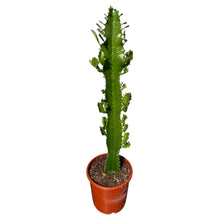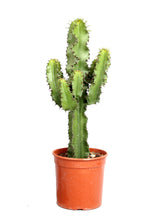Euphorbia abyssinica is part of the Euphorbiacae family and its native range is NE. Sudan to Somalia.
It is a succulent, tree-like euphorbia, it can reach up to ten metres in its natural environment which is montane woodlands, scrub savannah and on arid hillsides. The thick main stem becomes woody with age and is covered in paired spines.
Genus name comes from the Latin euphorbea, named after Euphorbus, Greek physician to the reputed discoverer of the plant (King Juba II of Numidia).
This plant is one of the more poisonous spurges; the latex is very bitter and acrid, containing diterpenes and is considered highly toxic. Sap causes severe skin irritation & severe eye pain, including temporary blindness that can last several days. All parts are highly toxic, possibly fatal, if ingested.
Light: Allow the plant to see the sun for as many hours of the day as possible; the plant ought to be able to see sun from where it is positioned in the home.
Water: Allow the potting mix to dry out completely in between waterings; Euphorbia store the water they need for photosynthesis inside their stems. Before watering, aerate the potting mix with a few pokes of a skewer or blunt stick, pour water slowly over the top of the substrate and allow the water to pass through the drainage holes.
Potting mix: A well draining mix composed of coco coir, perlite or vermiculite and horticultural sand.
Fertilising: Feed every few waterings during the growing season. You can dilute fertiliser to half the recommended amount but never add more.
Temperature: Spring and summer 18-30˚C, autumn and winter 10-13˚C
Humidity: Average humidity; if the humidity is particularly high, good ventilation is key to prevent mildew and fungal disease.
Euphorbia are toxic, keep out of reach of pets and children.



